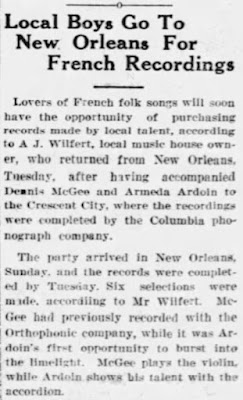This music (referred to variously among black Creoles as “French music,” “French la la,” as well as just “la la”) had introduced the diatonic one-row accordion as lead instrument. In the early years, it was often the sole instrument backing the human voice, as well as played solo or accompanied by a fiddle. Author Roger Wood claims la la was undoubtedly influenced by Cajun music in which both accordion and fiddle were already established as alternating lead instruments.1 Black Creoles like Ardoin used the same style as the white Creoles, making their sound quite indistinguishable. According to Roger Wood:
To my ears, the recordings of Amédé Ardoin did not sound all that different from . . . Cajun accordionists I had heard on records.”1
 |
| Eunice News Dec 13, 1929 |
However, Jeremy Simien, a 19th century Louisiana portraiture expert and collector of Creole material culture, states it's more likely white Creoles and well off Creoles of color mirrored each other in style and in most aspects of culture. Researchers like Simien believe it's impossible to say that Creole la la was undoubtedly influenced by Cajun music. Cajun/Creole were indistinguishable at some points in time.5
Comment donc, je vas faire, Joline?
Ta mom m’a pas voulu, comment je vas faire, chère?
Ayou c’est je vas aller, Joline? Ayou c’est je vas aller?
C’est toi toujours, t’étais, t’étais pas là, yaille,
Comment tu veux que je vas à ma maison?
Oh yaille, ma chère, tu m’as abandonné, yaille,
Comment tu veux que je vivre, Joline, c’est pas ma faute, catin,
Comment tu veux ton pop et mom a dit tout le temps, "Joline,
Vient donc avec moi." Je peux pas te revoir
C’est rapport à tu jolie, mignonne.Hé, bonsoir, bonsoir catin,Comment tu veux que je peux faire donc, m’en aller, mignonne, Joline,Et te quitte-toi en arrière, ye yaille,Il faut que tu t’en aller par rapport à ta mom, chère,"T’après venir avec moi, mais, toi, Joline."
 |
| Amede Ardoin |
Many of Ardoin’s recorded performances featured accompaniment by legendary Cajun fiddler Dennis McGee in a biracial collaboration that was, and has to this day remained, fairly rare in the history of black Creole music. Moreover, Ardoin sang in a tense, high-pitched voice with a strong, pleading tone in the manner of the classic Cajun singers (as opposed to the open-throated technique more common in African-American vocalizing). His instrument was the traditional single-row diatonic accordion, and his music was based mainly on the popular Cajun waltzes, one-steps, and two-steps.1 The duo cut their first recordings together in 1929 at a joint Columbia/Okeh field session in New Orleans under the direction of the Okeh A&R man and talent scout Polk C. Brockman. At this historic session, Ardoin and McGee waxed six Cajun waltzes and two steps, with the accordion and fiddle sharing the lead, including the now classic "Two Step de La Prairie Soileau". It was an ode to one of the many prairies of Louisiana, this one settled by the Soileau family of Louisiana, located in today's Allen parish. Today, the community of Soileau is situated between Oberlin and Elton.4
So how will I handle this, Joline?
Your mom didn't want me, how will I handle this, dear?
Where is it that I'll go, Joline? Where is it that I'll go?
It's you always, you were, you were not there, yaille,
How you want me to go back home?
Oh yaille, my dear, you have abandoned me, yaille,
How do you want me to live, Joline, it' snot my fault, pretty doll,
How you want your dad and mom who've always said "Joline,
Come with me." I can't see you again,
It's because you're so pretty, my cutie.Hey, goodnight, goodnight pretty doll,How do you want me to handle this? I'm going away, cute Joline,And leaving you behind, ye yaille,It's necessary that you leave because of your mom, dear,"You're coming with me, well, you Joline."
With Dennis McGee backing him up on fiddle, they created a rhythmic, repetative verse that continues from start to finish. It featured his common lament about a woman named Joline. But not all of Ardoin's performances named names. Goldman Thibodeaux claims to be the last living person to have seen Ardoin perform when Thibodeaux was 8 years old:
He was coming for a Sunday afternoon house party, and for three hours he sat in a corner and played, making up songs on the spot. Amede, he could put the words in a way, the girl knew he was talking about her, the man knew he was talking about him, but he wouldn't name anybody's name.2
- Southeast Texas: Hot House of Zydeco by R. Wood.
- http://www.nola.com/music/index.ssf/2015/05/zydeco_amede_ardoin_louisiana.html
- http://www.mtv.com/news/2981450/zydeco-grammys-gone/
- Hidden in the Mix: The African American Presence in Country Music edited by Diane Pecknold
- Disucssions with Jeremy K. Simien
- Lyrics by Jordy A
Find:
Cajun Dance Party: Fais Do-Do (Legacy/Columbia, 1994)
Cajun Origins (Catfish, 2001)
Mama, I'll Be Long Gone : The Complete Recordings of Amede Ardoin, 1929-1934 (Tompkins Square, 2011)
Cajun Dance Party: Fais Do-Do (Legacy/Columbia, 1994)
Cajun Origins (Catfish, 2001)
Mama, I'll Be Long Gone : The Complete Recordings of Amede Ardoin, 1929-1934 (Tompkins Square, 2011)


No comments:
Post a Comment
Got info? Pics? Feel free to submit.